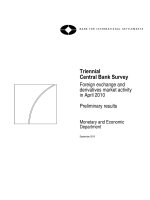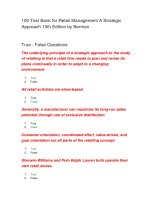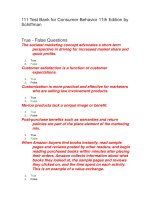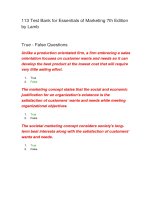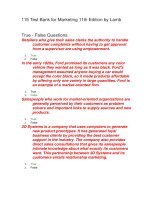Derivatives markets 2e by robert l mcdonald
Bạn đang xem bản rút gọn của tài liệu. Xem và tải ngay bản đầy đủ của tài liệu tại đây (19.13 MB, 996 trang )
The Addison-Wesley Series in Finance
Copeland/Weston
Financial Themy
and Cmporate Policy
Dufey/Giddy
Cases in International Finance
Eakins,
Finance: Investments,
Institutions, and Management
Eiteman!Stonehill!Moffett
- Multinational Business Finance
Gitman
Principles ofManagerial Finance
Gitman
Principles ofManagerial Finance
-Brief Edition
Gitman/Joehnk
Fundamentals of Investing
Gitman!Madura
Introduction to Finance
Hughes/MacDonald
International Banking:
Text and Cases
Madura
Personal Finance
Marthinsen
Risk Takers: Uses and Abuses
of Financial Derivatives
McDonald
Derivatives Markets
Megginson
Cmporate Finance Themy
Melvin
International Money and Finance
Mishkin/Eakins
Financial Markets and Institutions
Moffett
Cases in International Finance
Moffett/Stonehill!Eiteman
Fundamentals of
Multinational Finance
Rejda
Principles of Risk Management
and Insurance
Solnik!McLeavey
International Investments
Derivatives
Markets
Second Edition
R 0 B E R T L. M c D 0 N A L D
Northwestern University
Kellogg School of Management
Boston San Francisco New York
London Toronto Sydney Tokyo Singapore Madrid
Mexico City Munich Paris Cape Town Hong Kong Montreal
Editor-in-Chief: Denise Clinton
Senior Sponsoring Editor: Donna Battista
Senior Project Manager: Mary Clare McEwing
Development Editor: Marjorie Singer Anderson
Senior Production Supervisor: Nancy Fenton
Executive Marketing Manager: Stephen Frail
Design Manager: Regina Hagen Kolenda
Text Designer: Regina Hagen.Kolenda
Cover Designer: Rebecca Light
Co�er and Interior Image: Private Collection/Art for After Hours/SuperStock
Senior Manufacturing Btt')'er: Carol Melville
Supplements Editor: Marianne Groth
Project Management: Elm Street Publishing Services, Inc.
p
Co yright ©2006 Pearson Education, Inc.
All rights reserved. No part of this publication may be reproduced, stored in a retrieval system,
or transmitted, in any form or by any means, electronic, mechanical, photocopying, recording,
or otherwise, without the prior written permission of the publisher.
For information on obtaining permission for the use of material from this work, please submit
a written request to Pearson Education, Inc., Rights and Contracts Department, 75 Arlington
Street, Suite 300, Boston, MA 02116 or fax your request to (617) 848-7047 . Printed in the
United States of America .
Library of Congress Cataloging-in-Publication Data
McDonald, Robert
L.
(Robert Lynch), 1954-
Derivatives markets, 2e I Robert
p.cm.
Includes index.
ISBN 0-321-28030-X
1. Derivative securities. I. Title.
HG6024.A3 M3946 2006
332.64'5-dc21
ISBN 0-321-28030-X
12345678910-HT-09 08 07 06 05
L.
McDonald.
Fo1· Irene, Claire, David, and Hemy
Preface
Chapter 1
1.1
XX1
Comparing a Forward and Outright
Purchase
Uses of Derivatives
Credit Risk
3
2.2
3
The Role of Financial Markets
Risk-Sharing
4
How Are DerivativesUsed?
Option
2.3
7
Short-Selling
37
38
39
Payoff and Profit for aWritten Put
Option
40
The "Moneyness" of an Option
11
2.4
14
Risk and Scarcity in Short-Selling
33
Put Options
Option
10
12
The Lease Rate of an Asset
32
Payoff and Profit for a Purchased Put
Buying and Short-Selling Financial
Assets 11
Buying anAsset
31
Payoff and Profit for aWritten Call
Option
6
Growth in DerivativesTrading
1.4
Call Options
Payoff and Profit for a Purchased Call
5
Derivatives in Practice
30
30
Option Terminology
FinancialMarkets and theAverages 4
1.3
28
Cash Settlement Versus D� livery
2
FinancialEngineering and Security
1.2
Diagrams
1
Perspectives on Derivatives
Design
Zero-Coupon Bonds inPayoff and Profit
Introduction to Derivatives
What Is a Derivative?
26
LongPositions 44
15
Short Positions
Chapter Sumn!al)' 16
Further Reading 16
Problems 17
43
Summary of Forward and Option
Positions 43
2.5
44
Options Are Insurance
45
Homeowner'sInsuranceIs aPutOption
45
ButIThoughtInsurance Is Prudent and Put
Options Are Risky... 47
PART ONE
Call OptionsAreAlsoInsurance
INSURANCE,
2.6
Example: Equity-Linked CDs
47
48
HEDGING, AND SIMPLE STRATEGIES
Graphing the Payoff on the CD 49
19
Economics of the CD 50
WhyEquity-Linked COs?
Chapter 2
and Options
2.1
An Introduction to Forwards
21
Forward Contracts
21
ThePayoff on a Forward Contract
Graphing thePayoff on a Forward
Contract 25
23
51
Chapter Sumn!al)' 52
Further Reading 53
Problems 54
Appendix 2.A: More on Buying a Stock
Option 56
Dividends
56
vii
Viii
� C O N T E NTS
Exercise
Insurance: Guaranteeing a MaximumPrice
57
with a Call Option
Margins for Written Options 57
4.3
Taxes 58
Strategies
3.1
10 3
Reasons Not to Hed ge
59
Basic Insurance Strategies
10 1
Reasons to Hed ge
Insurance, Collars, and Other
59
4.4
Floors' 59
Golddiggers Revisited
Other CollarStrategies
Selling Insurance 6 3
Paylater Strategies
Synthetic Forwards
66
4.5
68
1 13
70
QuantityUncertainty
Bull and Bear Spread s
71
Chapter Stmti11G1)' 119
Further Reading 120
Problems 120
Ratio Spread s
Collars
3.4
72
73
Speculating on Volatility
Strad d les
78
78
Butterfly Spread s
PART 1WO
81
82
Chapter 5
Chapter Summary 85
Further Reading 86
Problems 87
Management
4.1
Futures
5.1
5.2
92
Arbitrage
5.3
96
Basic Risk Management: The Buyer's
Perspective 98
98
129
129
Pricing Prepaid Forward s with
Divid end s
95
Hed ging with a Forward Contract
128
Present Value
93
Ad justing theAmount ofInsurance
127
Pricing thePrepaid Forward by
Insurance: Guaranteeing a MinimumPrice
4.2
Alternative Ways to Buy a Stock
Prepaid Forward Contracts on
Stock 128
Pricing thePrepaidForward by Discounted
Basic Risk Management: The
Producer's Perspective 91
Insuring by Selling a Call
Financial Forwards and
127
Analogy
91
with a Put Option
125
Pricing the Prepaid Forward by
Introduction to Risk
Hed gingwith a Forward Contract
FORWARDS,
FUTURES, AND SWAPS
Example: Another Equity-Linked
Note 83
Chapter 4
116
73
Asymmetric Butterfly Spread s
3.5
113
114
3.3- Spreads and Collars
Box Spread s
10 8
1 12
Selecting the Hedge Ratio
Cross-Hed ging
106
108
Selling the Gain: Collars
Insuring a Short Position: Caps 6 2
Put-Call Parity
106
EmpiricalEvidence onHed ging
Insuring a LongPosition:
3.2
100
An ExampleWhereHed gingAd d s
Value
Chapter 3
99
Why Do Firms Manage Risk?
13 1
Forward Contracts on Stock
133
Creating a SyntheticForward
Contract
135
Synthetic Forward s in Market-Making and
Arbitrage
136
·
C O N T E NTS
An ApparentArbitrage and
No-Arbitrage Bounds withTransaction
Costs
Resolution
13 8
Quasi-Arbitrage
140
6.5
5.4
14 1
Futures Contracts
142
14 3
Margins and Marking toMarket
144
Comparing Futures and Forward
5.5
Quanta Index Contracts
14 9
Uses of Index Futures
150
AssetAllocation
150
Cross-hedging with Index Futures
5.6
Currency Contracts
154
CurrencyPrepaid Forward
Currency Forward
Eurodollar Futures
155
Storage Costs and ForwardPrices
18 1
18 2
Gold Futures
18 2
184
18 7
BasisRisk
197
15 6
Weather Derivatives
Futures
6.1
19 9
160
19 9
Chapter SummGI)' 200
Further Reading 201
Problems 201
Chapter 7
Futures
7.1
Interest Rate Forwards and
205
Bond Basics
205
Zero-Coupon Bonds
20 6
Implied Forward Rates
Chapter 6
18 7
6.8 Seasonality: The Corn Forward
Market 188
6.9 Natural Gas 191
6.10 Oil 194
6.11 Commodity Spreads 195
6.12 Hedging Strategies 196
HedgingJet Fuel with Crude Oil
Chapter SumnWI)' 160
Further Reading 162
Problems 162
Appendix 5.A: Taxes and the Forward
Price 166
Appendix S.B: Equating Forwards and
Futures 166
Coupon Bonds
Commodity Forwards and
20 8
210
Zeros from Coupons
169
·
2 11
Interpreting the Coupon Rate
Introduction to Commodity
Forwards 169
17 9
Storage Costs and the Lease Rate
Evaluation of Gold Production
15 6
Covered InterestArbitrage
5.7
15 1
2 12
Continuously Compounded Yields
6.2
Equilibrium Pricing of Commodity
Forwards 171
6.3
Nonstorability: Electricity
6.4
Pricing Commodity Forwards by
Arbitrage: An Example 174
·
172
17 8
181
Gold Investments
Arbitrage in Practice: S&P 50 0 Index
147
Carry Markets
The Convenience Yield
6.7
14 6
Arbitrage
17 6
178
Forward Prices and the Lease Rate
6.6
The S&P 50 0 Futures Contract
Prices
The Commodity Lease Rate
The LeaseMarket for a Commodity
An Interpretation of the Forward Pricing
Formula
175
Pencils Have aPositive Lease Rate
13 9
Does the ForwardPricePredict the Future
Price?
ix
�
7.2
2 13
Forward Rate Agreements, Eurodollars,
and Hedging 214
Forward RateAgreements
Synthetic FRAs
214
216
Eurodollar Futures
218
Interest Rate Strips and Stacks
223
X
7.3
� C O N T E N TS
Duration and Convexity
Duration
223
Further Reading 275
Problems 275
224
DurationMatching
Convexity
227
228
7.4
Treasury-Bond and Treasury-Note
Futures 230
PART THREE
7.5
Repurchase Agreements
Chapter 9
233
Chapter Summary 235
Further Reading 237
Problems 237
Appendix 7.A: Interest Rate and Bond Price
Conventions 241
Bonds
Bills
Chapter 8
8.1
244
Swaps
248
250
255
304
Chapter Szmmzary• 305
Further Reading 306
Problems 306
Appendix 9.A: Parity Bounds for American
Options 310
Appendix 9.B: Algebraic Proofs of
Strike-Price Relations 311
260
26 2
26 3
267
267
268
The Commodity Swap Price 26 8
Swaps with Variable Quantity and
8.5
8.6
29 9
Exercise andMoneyness
264
Currency Swap Formulas
29 4
29 7
Different Strike Prices
257
26 1
Other Currency Swaps
29 3
Time to Expiration
258
Am ortizing and Accreting Swaps
29 3
Early Exercise forAmerican Options
Computing the Swap Rate in General
Why Swap Interest Rates?
29 0
Comparing Options with Respect to
Style, Maturity, and Strike 292
Prices
254
The Swap's Implicit Loan Balance
28 8
28 9
Maximum andMinimum Option
25 3
Pricing and the Swap Counterpart}'
Commodity Swaps
28 6
European VersusAmerican Options
254
A SimpleInterest Rate Swap
Price
9.3
250
The Market Value of a Swap
8.4
28 6
Generalized Parity and Exchange
Options 287
Currency Options
Physical Versus FinancialSettlement
Currency Swaps
28 3
Options to Exchange Stock
Why Is the Swap Price Not $20 .50 ?
Deferred Swap s
281
What Are Calls andPuts?
247
The Swap Curve
Put-Call Parity
Options on Bonds
247
Interest Rate Swaps
281
Options on Currencies
9.2
279
Parity and Other Option
Options onStocks
24 2
The Swap Counterpart}'
8.3
9.1
An Example of a Commodity
Swap
8.2
Relationships
OPTIONS
26 9
Swaptions 271
Total Return Swaps
Chapter Sumnzal)' 274
Chapter 10
Pricing: I
10.1
Binomial Option
313
A One-Period Binomial Tree
Computing the OptionPrice
272
The Binomial Solution
313
3 14
3 15
Arbitraging a Mispriced Option
3 18
C O N T E N TS
A Graphical Interpretation of the Binomial
Formula
3 20
Constructing a BinomialTree
3 21
Another One-PeriodExample
3 22
Summary
3 22
Many Binomial Periods
Option on a Srock Index
Options on Currencies
Forward
Pricing: II
330
3 32
332
3 34
3 35
Utility-Based Valuation
336
Risk-Neutral Pricing
Example
Formula
343
Understanding Early Exercise
11.2
Understanding Risk-Neutral
Pricing 346
The Risk-Neutral Probability
343
12.1
Valid?
12.2
The Binomial Tree and
Lognormality 351
Continuously Compounded Returns
The Binomial Model
3 55
Lognormality and the Binomial
Model
3 55
379
Applying the Formula to Other
Assets 379
Dividends
380
Options on Currencies
352
The Standard Deviation of Returns
3 75
378
Options on Srocks with Discrete
351
Modeling Stock Prices as a Random
Walk
Introduction to the Black-Scholes
Formula 375
WhenI s the Black-Scholes Formula
3 47
TheRandomWalkModel
The Black-Scholes
Put Options
Pricing an OptionUsing Real
11.3
372
375
Call Options
346
Options on Futures
3 53
3 54
12.3
37 1
37 1
Why Risk-Neutral PricingWorks
Chapter 12
11.1
3 69
Standard Discounted Cash Flow
Binomial Option
Probabilities
363
Chapter Summary 365
Further Reading 366
Problems 366
Appendix ll.A: Pricing Options with True
Probabilities 369
Appendix 11.B: Why Does Risk-Neutral
Pricing Work? 369
Chapter Summary 337
Further Reading 337
Problems 338
Appendix 1 O.A: Taxes and Option
Prices 341
Chapter 1 1
3 62
A BinomialTreeUsing the Prepaid
3 30
Options on Commodities
Summary
Tree
3 23
Options on Futures Contracts
Options on Bonds
361
Problems with the Discrete Dividend
323
3 26
Put Options 328
American Options 329
Options on Other Assets
3 59
Estimating Volatility 360
Stocks Paying Discrete
Dividends 361
Modeling Discrete Dividends
Two or More Binomial Periods
ATwo-PeriodEuropean Call
10.3
10.4
10.5
11.4
11.5
xi
35 8
Is the Binomial Model Realistic?
Risk-Neutral Pricing
10.2
Alternative BinomialTrees
3 19
�
Option Greeks
38 1
38 1
382
Definition of the Greeks
382
Greek Measures for Portfolios
Option Elasticity
389
3 88
3 73
Xii
12.4
12.5
� C O N T E NTS
Profit Diagrams Before Maturity
Theta: Accounting forTime
Calendar Spreads 3 9 7
Understanding theMarket-Maker's
Implied Volatility
Profit
400
Computing Implied Volatility
UsingImplied Volatility
12.6
Delta-Gamma Approximations 4 24
395
Purchased Call Option 3 96
40 0
13.5
Re-Hedging?
404
Gamma-Neutrality
13.6
432
433
Market-Making as Insurance
436
Insurance 436
Market-Makers
43 7
Chapter Swnmmy 438
Further Reading 438
Problems 438
Appendix 13.A: Taylor Series
Approximations 441
Appendix 13.B: Greeks in the Binomial
Model 441
410
Vega
43 1
Delta-Hedging inPractice
Chapter Summary 405
Further Readilzg 405
Problems 406
Appendix 12.A: The Staizdard Normal
Distribution 409
Appendix 12.B: Formulas for Option
Greeks 410
Theta
429
4 29
What Is theAdvantage to Frequent
Perpetual Calls 404
Gamma
The Black-Scholes Analysis
Delta-Hedging ofAmerican Options 43 0
403
Barrier Present Values 403
. Delta
4 27
TheBlack-ScholesArgument
40 2
Perpetual American Options
Perpetual Puts
4 25
4 10
410
411
Rho 4 11
Psi
Chapter 13
14.1
14.2
Market-Making and
Delta-Hedging
13.1
13.2
Chapter 14
411
41 3
What Do Market-Makers Do?
Market-Maker Risk 414
XYZ's HedgingProblem
413
ComparingAsian Options 447
AnAsian Solution forXYZ
Delta and Gamma a sMeasures of
Exposure
13.3
417
14.4
4 22
The Mathematics of
Delta-Hedging 422
Compound Options
453
454
Options on Dividend-Paying Stocks
CurrencyHedging with Compound
Delta-Hedging for Several Days 4 20
A Self-FinancingPortfolio: The Stock
Options 456
14.5
14.6
Gap Options
457
Exchange Options
459
European Exchange Options 459
Using Gamma to BetterApproximate the
Change in the Option Price
450
Compound OptionParity
Interpreting theProfit Calculation 4 18
13.4
448
449
Types ofBarrier Options
41 7
.Moves Onea
Barrier Options
CurrencyHedging 451
An Example of Delta-Hedging for 2
Days
14.3
41 6
Delta-Hedging
445
Options on theAverage 446
Option Risk in theAbsence of
Hedging 4 1 4
443
Exotic Options: I
Introduction 443
Asian Options 444
4 23
Chapter Summary 461
Further Reading 462
455
C O N T E N TS
Chapter 16
Problems 462
Appendix 14.A: Pricing Formulas for
Exotic Options 466
Applications
Asian Options Based on the Geometric
Average
16.1
Corporate
503
Equity, Debt, and Warrants
Multiple DebtIssues
46 7
Infinitely Lived Exchange Option
503
Debt andEquity as Options 503
466
Compound Options
xiii
�
Warrants
46 8
51 1
512
Convertible Bonds
CallableBonds
513
516
Bond ValuationBased on theStockPrice
520
PART FOUR
OtherBond Features S20
FINANCIAL
PutWarrants
ENGINEERING AND APPLICATIONS
16.2
471
ValuationInputs
Financial Engineering and
Security Design
The Modigliani-Miller Theorem
15.2
Pricing and Designing Structured
Notes 474
Zero-Coupon Bonds
Option Grants
473
16.3
Equity-LinkedBonds 476
Currency-LinkedBonds
482
483
483
486
48 8
Strategies Motivated by Tax and
Regulatory Considerations 490
Capital Gains Deferral·
490
Tax-DeductibleEquity
495
Chapter Summary 498
Further Reading 498
Problems 498
17.2
547
Real Options
Investment and the NPV Rule
StaticNPV
Engineered Solutions for
Golddiggers 486
Notes withEmbedded Options
15.5
Chapter 17
17.1
Alternative Structures 48 5
Gold-LinkedNotes
The Use of Collars in
Acquisitions 538
Chapter Summary 542
Further Reading 542
Problems 543
482
Valuing and Structuring anEquity-Linked
CD
53 4
53 8
Bonds with Embedded Options
Options inEquity-LinkedNotes
53 1
532
The Northrop Grumman-TRY Merger
478
48 1
Options in CouponBonds
52 8
Level3 Communications
CouponBonds 475
Commodity-Linked Bonds
52 7
Repricing of Compensation Options
Reload Options
474
523
525
AnAlternativeApproach to Expensing
473
15.1
15.4
Compensation Options
Whose Valuation?
Chapter 15
15.3
522
548
548
The CorrectUse ofNPV
549
The Project as an Option
550
Investment under Uncertainty
551
A Simple DCFProblem 551
Valuing Derivatives on the Cash Flow
552
Evaluating a Project with a2 -Year
InvestmentHorizon
554
Evaluating the Project with anInfinite
InvestmentHorizon
558
XiV
17.3
17.4
� C O N T E N TS
Real Options in Practice
Lognormal ConfidenceIntervals 6 0 0
558
Peak-Load Electricity Generation 559
The Conditional Expected Price 6 0 2
Research andDevelopment
The Black-Scholes Formula 6 04
563
Commodity Extraction as an
Option 565
18.5
Single-Barrel Extraction under
18.6
Certainty 56 5
Single-BarrelExtraction under
Histograms 6 0 8
Uncertainty 569
Valuing anInfinite Oil Reserve
17.5
Normal Probability Plots 6 09
570
Commodity Extraction with
Shut-Down and Restart Options
PermanentShuttingDown
Chapter Summary 613
Further Reading 613
Problems 614
Appendix 18.A: The Expectation of a
Lognomzal Variable 615
Appendix 18.B: Constructing a Normal
Probability Plot 616
572
574
InvestmentWhen Shutdown Is
Possible 576
RestartingProduction
Additional Options
Estimating the Parameters of a
Lognormal Distribution 605
How Are Asset Prices
Distributed? 608
57 8
57 8
Chapter Swnmal)' 579
Further Reading 580
Problems 580
Appendix 17.A: Calculation of Optimal
Time to Drill an Oil Well 583
Ap pendix 17.B: The Solution with
Shutting Down and Restarting 583
Chapter 19
19.1
61 7
Monte Carlo Valuation
Computing the Option Price as a
Discounted Expected Value 617
Valuation with Risk-Neutral
Probabilities 61 8
Valuation withTrue Probabilities 6 19
19.2
Computing Random Numbers
621
UsingSums of UniformlyDistributed
PART FIVE
THEORY
Random Variables 6 22
ADVANCED PRICING
Using theInverse CumulativeNormal
5 85
Distribution 6 22
19.3
Chapter 1 8
Distribution
18.1
The Lognormal
Simulating a Sequence of Stock
587
The Normal Distribution
Prices 623
587
Converting a-Normal Random Variable to
19.4
Sums ofNormal Random Variables
The Lognormal Distribution 593
A Lognormal Model of Stock
Prices 595
18.4
Lognormal Probability
Calculations 598
599
624
Call 6 25
591
18.2
18.3
Monte Carlo Valuation
Monte Carlo Valuation of aEuropean
StandardNormal 590
Probabilities
Simulating Lognormal Stock
Prices 623
Accuracy of Monte Carlo 6 26
ArithmeticAsian Option 6 27
19.5
Efficient Monte Carlo Valuation
630
Control VariateMethod 63 0
Other Monte Carlo Methods 63 2
19.6
Valuation of American Options
633
C O N T E N TS
19.7
19.8
The Poisson Distribution 636
SimulatingJumps with the Poisson
Distribution 639
MultipleJumps 6 4 3
19.9
Further Reading 674
Problems 675
Chapter 2 1
Simulating Correlated Stock
Prices 643
Equation
Generating11 Correlated Lognormal
21.1
Random Variables 6 44
Chapter Summary 645
Further Reading 645
Problems 646
Appendix 19.A: Formulas for Geometric
Average Options 648
Chapter 20
Lemma
20.1
20.2
Dividend-Paying Stocks 6 8 1
.
The General Structure 6 8 1
21.2
The Black-Scholes Equation
681
Verif ying the Formula f or a
Derivative 6 8 3
The Black-Scholes Equation and
Equilibrium Returns 6 8 6
The Black-Scholes Assumption about
Stock Prices 649
Brownian Motion
650
WhatIf the Underlying AssetI sNot an
InvestmentAsset?
21.3
6 55
Relative Importance of theDrift and Noise
DerivativePrices as DiscountedExpected
Cash Flows 69 2
21.4
21.5
Terms 6 56
69 7
Multiplication Rules 6 58
The Sharpe Ratio
20.5
The Risk-Neutral Process
20.6
Ito's Lemma
Chapter Summa/)' 698
Further Reading 698
Problems 699
Appendix 21.A: Multivariate
Black-Scholes Analysis 700
Appendix 21.B: Proof of Proposition 21.1
701
659
660
663
Functions of anIto Process 66 3
MultivariateIto's Lemma 665
Valuing a Claim on sa
666
TheProcess Followed by S"
66 7
Proving the Proposition 66 8
Specific Examples 669
Valuing a Claim on S" Q"
20.8 Jumps in the Stock Price
Chapter Sumntal)' 674
Changing the Numeraire 693
Option Pricing When the Stock Price
CanJump 696
Merton's Solution f or DiversifiableJumps
Correlated Ito Processes 6 57
20.4
690
TheBackwardEquation 691
The Ornstein-Uhlenbeck Process 6 54
655
Risk-Neutral Pricing
Equation 690
Arithmetic BrownianMotion 6 5 3
Geometric Brownian Motion
688
Interpreting the Black-Scholes
Properties of BrownianMotion 6 5 2
20.7
Differential Equations and Valuation
under Certainty 679
Bonds 6 8 0
649
Lognormality
The Black-Scholes
679
TheValuation Equation 6 8 0
Brownian Motion and Ito's
Definition of BrownianMotion 6 50
20.3
XV
�
670
672
Chapter 22
22.1
Exotic Options: II
Ali-or-Nothing Options
703
703
Terminology 70 3
Cash-or-Nothing Options
704
Asset-or-Nothing Options
706
XVi
�
C O N T E NTS
706
Ordinary Options and Gap Options
23.3
Options
22.2
PricingVolatility
707
Ali-or-Nothing Barrier Options
710
23.4
Cash-or-Nothing Barrier Options 7 1 0
Asset-or-Nothing Barrier Options
Rebate Options
Quanto�
TheHestonModel
717
Evidence
718
The Dollar Perspective
7 21
Dollar-DenominatedInvestor
22.5- Currency-Linked Options
7 24
727
Foreign Equity Call Struck inForeign
7 28
Foreign Equity Call Struck in Domestic
Chapter 24
24.1
7 29
22.6
Rates
Exchange Options
73 2
Bonds
24.2
73 5
Volatility
ComparingVasicek and CIR
741
741
23.2
Measurement and Behavior of
Volatility 744
Bond Options, Caps, and the Black
Model 790
24.4
A Binomial Interest Rate Model
793
79 4
Yields andExpectedInterest Rates
796
OptionPricing 79 7
744
746
Time-Varying Volatility: ARCH
788
24.3
Zero-CouponBond Prices
ExponentiallyWeightedMovingAverage
747
7 51
Realized QuadraticVariation
785
The Cox-Ingersoll-Ross Model 7 8 7
Implied Volatility
The GARCH Model
Equilibrium Short-Rate Bond Price
Models 785
TheVasicek Model 7 8 6
23.1
HistoricalVolatility
781
784
The Rendelman-BartterModel
Chapter Swnnial)' 736
Further Reading 736
Problems 737
Chapter 23
780
Delta-Gamma Approximations for
732
Options on the Best ofTwoAssets 733
Basket Options
780
A nEquilibriumEquation for Bonds
73 1
Other Multivariate Options
779
An ImpossibleBondPricingModel
73 0
Equity-Linked Foreign Exchange
Call
Interest Rate Models
Market-Making and Bond
Pricing 779
TheBehavior of Bonds andInterest
Fixed Exchange Rare Foreign Equity
Call
76 8
771
Chapter Summa/)' 773
Further Reading 773
Problems 774
Appendix 23.A 777
A Binomial Model for the
Currency
759
Extending the Black-Scholes Model
763
Constant Elasticity ofVariance 766
The YenPerspective 7 20
Currency
757
758
Jump Risk and Implied Volatility 764
715
7 16
Barrier Options
22.4
Hedging and Pricing Volatility
Variance andVolatility Swaps
Delta-Hedging Ali-or-Nothing
755
24.5
The Black-Derman-Toy Model
Verifying Yields
802
VerifyingVolatilities
8 03
Constructing a Black-Derman-Toy
Tree
8 04
Pricing Examples
805
798
C O N T E N TS
Chapter Szmzmary 808
Further Reading 808
Problems 809
Appendix 24.A: The Heath
farrow-Morton Model 811
Chapter 25
25.1
81 3
Value a t Risk
Value at Risk
813
Value at Risk f or One Stock 815
VaR f orTwo orMore Stocks 81 7
VaR f orNonlinear Portf olios 81 9
VaR f or Bonds 8 26
Estimating Volatility 830
Bootstrapping Return Distributions 83 1
25.2
Issues with VaR
832
PART SIX
APPENDIXES
Appendix A
The Greek Alphabet
Appendix B
Continuous
Compounding
B.1
B.2
26.1
26.2
Related Mod els 845
Bond Ratings and Default Experience
847
Using Ratings toAssessBankruptcy
Probability 84 7
Reduced FormBankruptcyModels 8 5 2
Credit Instruments
853
Collateralized DebtObligations 8 53
Credit Def ault Swaps and Related
Structures 858
Pricing a Def ault Swap 86 2
CDSIndices 86 4
C.2
C.3
jensen's Inequality
881
·
Example: The Exponential Function
881
Example: The Price of a Call 882
Proof ofJensen's Inequality 884
Problems 884
Appendix D
An Introduction to
Visual Basic for Applications
D.1
D.2
D.3
885
Calculations without VBA 885
How to Learn VBA 886
Calculations with VBA 886
Creating a Simple Function 886
Recovery Rates 8 50
26.4
Problems 878
C.1
Def ault atMaturity 843
26.3
The Language of Interest Rates 875
The Logarithmic and Exponential
Functions 876
Appendix C
Default Concepts and Terminology
841
The Merton Default Model 843
875
8 78
Subadditive RiskMeasures 83 7
841
873
Symm etry f or Increases and Decreases
835
Credit Risk
871
Changing Interest Rates 8 7 7
VaR and the Risk-Neutral Distribution
Chapter 26
xvii
Chapter SumnWI)' 866
Further Reading 867
Problems 867
Alternative RiskMeasures 83 2
Chapter Szmnnmy 838
Further Reading 839
Problems 839
�
A Simple Example of a Subroutine 888
Creating a Button toInvoke aSubroutine
888
Functions Can Call Functions 88 9
IllegalFunctionNames 88 9
Dif f erences between Functions and
Subroutines 8 9 0
XViii
D.4
� C O N T E N TS
Creating a BinomialTree
Storing and Retrieving Variables in a
Worksheet 890
Using aNamed Range to Read andWrite
Numbers f rom a Spreadsheet
8 91
Other Kind s o f Loops
D.9
Reading and Writing Arrays
Arrays as Outputs
Reading andWriting to CellsThat AreNot
Named
892
Using the Cells Functions to Read and
Write to Cells
D.S
Arrays as Inputs
D.lO
892
Reading f rom within a Function
Debugging
Iter!:ltion
8 97
899
A Simplefor Loop
899
896
Glossary
907
921
Bibliography
Index
905
9 06
Creating an Add-In
8 95
D.6 -Checking f!Jr Conditions
D.7 Arrays 897
D.8
Getting Excel to Generate Macros f or You
Recalculation Speed
8 94
DefiningArrays
9 03
904
UsingMultipleModules
UsingVBA to Compute the Black-Scholes
The Object Browser
Miscellany
901
9 01
904
8 93
Using Excel Functions from within
VBA 893
Formula
900
9 01
935
906
9 05
De
riva6v ; , have moved to the cent« of modem coq>nmte finance, ;nve"men", and
the management of financial institutions. They have also had a profound impact on
other management functions such as business strategy, operations management, and
marketing. A major drawback, however, to making the power of derivatives accessible
to students and practitioners alike has been the relatively high degree of mathematical
sophistication required for understanding the underlying concepts and tools.
With Robert McDonald' s Derivatives Markets, we finally have a derivatives text
that is a wonderful blend of the economics and mathematics of derivatives pricing and
easily accessible to MBA students and advanced undergraduates. It is a special pleasure
for me to introduce this new edition, since I have long had the highest regard for the
author's professional achievements and personal qualities.
The book' s orientation is neither overly sophisticated nor watered down, but rather
a mix of intuition and rigor that creates an inherent flexibility for the structuring of a
derivatives course. The author begins with an introduction to forwards and futures and
motivates the presentation with a discussion of their use in insurance and risk management. He looks in detail at forwards and futures on stocks, stock indices, currencies,
interest rates, and swaps. His treatment of options then follows logically from con
cepts developed in the earlier chapters. The heart of the text-an extensive treatment
of the binomial.option model and the Black-Scholes equation-showcases the author' s
crystal-clear writing and logical development of concepts. Excellent chapters on finan
cial engineering, security design, corporate applications, and real options follow and
shed light on how the concepts can be applied to actual problems.
The last third of the text provides an advanced treatment of the most important
concepts of derivatives discussed earlier. This part can be used by itself in an advanced
derivatives course, or as a useful reference in introductory courses. A rigorous de
velopment of the Black-Scholes equation, exotic options, and interest rate models are
presented using Brownian Motion and Ito's Lemma. Monte Carlo simulation methods
are also discussed in detail. New chapters on volatility and credit risk provide a clear
discussion of these fast-developing areas.
Derivatives concepts are now required for every advanced finance topic. There
fore, it is essential to introduce these concepts at an early stage of MBA and under
graduate business or economics programs, and in a fashion that most students can un
derstand. This text achieves this goal in such an appealing, inviting way that students
will actually enjoy their journey toward an understanding of derivatives.
·
EDUARDO 5. SCHWARTZ
xix
ThiTiy
yea.-' ago the Blaok-Scho!o' focmula wa, new, and derivative< wa, an e
modern finance. For example, corporations routinely hedge and insure using deriva
tives, finance activities with structured products, and use derivatives models in capital
budgeting. This book will help you to understand the derivative instruments that exist,
how they are used, who sells them, how they are priced, and how the tools and concepts
are useful more broadly in finance.
Derivatives is necessarily an analytical subject, but I have tried throughout to
emphasize intuition and to provide a common sense way to think about the formulas. I
do assume that a reader of this book already understands basic financial concepts such as
present value, and elementary statistical concepts such as mean and standard deviation.
Most of the book should thus be accessible to anyone who has studied elementary finance.
For those who want to understand the subject at a deeper level, the last part of the book.
develops the Black-Scholes approach to pricing derivatives and presents some of the
standard mathematical tools used in option pricing, such as Ito's Lemma. There are also
chapters dealing with applications: corporate applications, financial engineering, and
real options.
In order to make the book accessible to readers with widely varying backgrounds
and experiences, I use a "tiered" approach to the mathematics. Chapters 1-9 emphasize
present value calculations, and there is almost no calculus until Chapter 1 8 .
Most o f the calculations i n this book can b e replicated using Excel spreadsheets on
the CD-ROM that comes with the book. These allow you to experiment with the pricing
models and build your own spreadsheets. The spreadsheets on the CD-ROM contain
option pricing functions written in Visual Basic for Applications, the macro language in
Excel. You can easily incorporate these functions into your own spreadsheets. You can
also examine and modify the Visual Basic code for the functions. Appendix D explains
how to write such functions in Excel and documentation on the CD-ROM lists the option
pricing functions that come with the book. Relevant built-in Excel functions are also
mentioned throughout the book.
PLAN
OF
THE
BOOK
This book grew from my teaching notes for two MBA derivatives courses at Northwest
ern University's Kellogg School of Management. The two courses roughly correspond
xxi
xxii
�
P R E FA C E
to the first two-thirds and last third of the book. The first course i s a general introduction
to derivative products (principally futures, options, swaps, and structured products), the
markets in which they trade, and applications. The second course is for those wanting a
deeper understanding of the pricing models and the ability to perform their own analysis.
The advanced course assumes that students know basic statistics and have seen calculus,
and from that point develops the Black-Scholes option-pricing framework as fully as
possible. No one expects that a 1 0-week MBA-level course will produce rocket scien
tists, but mathematics is the language of derivatives and it would be cheating students
to pretend otherwise.
You may want to cover the material in a different order than it occurs in the book,
so I wrote chapters to allow flexible use of the material. I indicate several possible paths
through the material below. In many cases it is possible to hop around. For example, I
wrote the book expecting that the chapters on lognormality and Monte Carlo simulation
might be used in a first derivatives course.
The book has five parts plus appendixes. Part 1 introduces the basic building
blocks o{ derivatives: forward contracts and call and put options. Chapters 2 and 3
examine these basic instruments and some common hedging and investment strategies.
Chapter 4 illustrates the use of derivatives as risk management tools and discusses why
firms might care about risk management. These chapters focus on understanding the
contracts and strategies, but not on pricing.
Part 2 considers the pricing of forward, futures, and swaps contracts. In these
contracts, you are obligated to buy an asset at a pre-specified price, at a future date. The
main question is: What is the pre-specified price, and how is it determined? Chapter
5 examines forwards and futures on financial assets, Chapter 6 discusses commodities,
and Chapter 7 looks at bond and interest rate forward contracts. Chapter 8 shows how
swap prices can be deduced from forward prices.
Part 3 studies option pricing. Chapter 9 develops intuition about options prior to
delving into the mechanics of option pricing. Chapters 10 and 1 1 cover binomial option
pricing and Chapter 12, the Black-Scholes formula and option Greeks. Chapter 13
explains delta-hedging, which is the technique used by market-makers when managing
the risk of an option position, and how hedging relates to pricing. Chapter 14 looks
at a few important exotic options, including Asian options, barrier options, compound
options, and exchange options.
The techniques and formulas in earlier chapters are applied in Part 4. Chapter 15
covers financial engineering, which is the creation of new financial products from the
derivatives building blo cks in earlier chapters. Debt and equity pricing, compensation
options, and mergers are covered in Chapter 16. Chapter 17 studies real options-the
application of derivatives models to the valuation and management of physical invest
ments.
Finally, Part 5 explores pricing and hedging in depth. The material in this part
explains in more detail the structure and assumptions underlying the standard derivatives
models. Chapter 1 8 covers the lognormal model and shows how the Black-Scholes
formula is an expected value. Chapter 19 discusses Monte Carlo valuation, a powerful
and commonly used pricing technique. Chapter 20 explains what i t means to say that
W H AT Is N EW I N T H E S E C O N D E D I T I O N
�
xxiii
stock prices follow a diffusion process, and also covers Ito's Lemma, which is a key
result in the study of derivatives. (At this point you will discover that Ito's Lemma has
already been developed intuitively in Chapter 13, using a simple numerical example.)
Chapter 21 derives the Black-Scholes partial differential equation (PDE). Although
the Black-Scholes formula is famous, the Black-Scholes equation, discussed in this
chapter, is the more profound result. Chapter 22 covers exotic options in more detail
than Chapter 14, including digital barrier options and quantos. Chapter 23 discusses
volatility estimation and stochastic volatility pricing models. Chapter 24 shows how
_
the Black-Scholes and binomial analysis apply to bonds and interest rate derivatives.
Chapter 25 covers value-at-risk, and Chapter 26 discusses the burgeoning market in
credit products.
WHAT IS NEW IN THE SECOND EDITION
There are two new chapters in this edition, covering volatility and credit risk:
•
•
Chapter 23 covers empirical volatility models, such as GARCH and realized
volatility; financial instruments that can be used to hedge volatility, such as vari
ance swaps; and pricing models that incorporate j umps and stochastic volatility,
such as the Heston model.
Chapter 26 covers structural models of bankruptcy risk (the Merton model);
tranched structures such as collateralized debt obligations; credit default swaps
and credit indexes.
There are numerous changes and new examples throughout the book. Among the
more important changes are the following:
o
An expanded discussion of bond convexity
o
An expanded treatment of computing hedge ratios
o
An expanded treatment of convertible and callable bonds
•
•
•
Discussion of the new option expensing rules in FAS 123R and the B ulow-Shoven
expensing proposal
Discussion of a variable prepaid forward on Disney stock issued by Roy Disney
In-depth discussion of a mandatorily convertible bond issued by Marshall & Ilsley,
including pricing and structuring
•
The use of simulation to price American options
•
Additional discussion of implied volatility
•
Enhanced discussion of the link between discounted cash flow valuation and risk
neutral valuation
:xxiv
� P R E FA C E
•
•
A n expanded discussion o f value-at-risk
New spreadsheet functions for pricing options with fixed dividends, CEV option
pricing, the Merton jump model, and others
NAVIGATING THE MATERIAL
There are potentially many ways to cover the material in this book. The material is
generally presented in order of increasing mathematical difficulty, which means that
related material is sometimes split across distant chapters. For example, fixed income is
covered in Chapters 7 and 24, and exotic options in Chapters 14 and 22. Each of these
chapters is at the level of the neighboring chapters. As an illustration of one way to use
the book, here is the material I cover in the courses I teach (within the chapters I skip
some specific topics due to time constraints):
o
Introductory course: 1-6, 7. 1 , 8-1 0, 1 1 . 1-1 1 .2, 12, 1 3 . 1-13.3, 14, 15.4--15.5, 1 6,
o
Advanced course: 13, 1 8-22, 7, 8, 15. 1-15.3, 23, 24, 25, 26.
17.
The table on page xxv outlines some possible sets of chapters to use in courses that
have different emphases. There are a few sections of the book that provide background
on topics every reader should understand. These include short-sales (Section 1 .4), con
tinuous compounding (Appendix B), prep�d forward contracts (Sections 5 . 1 and 5.2),
and zero-coupon bonds and implied forward rates (Section 7.1).
A NOTE ON EXAMPLES
Many of the numerical examples in this book display intermediate steps to assist you
in following the calculations. In most cases it will also be possible for you to cre
ate a spreadsheet and compute the same answers starting from the basic assumptions.
However, numbers displayed in the text are generally rounded to three or four decimal
points, while spreadsheet calculations have many more significant digits. This creates a
dilemma: Should results in the book match those you would obtain using a spreadsheet,
or those you would obtain by computing the displayed equations?
As a general rule, the numerical examples in the book will provide the results
you would obtain by entering the equations directly in a spreadsheet. The displayed
calculations will help you follow the logic of a calculation, but a spreadsheet will be
helpful in reproducing the final result.
SUPPLEMENTS
A robust package of ancillary materials for both instructors and students accompanies
the text.
